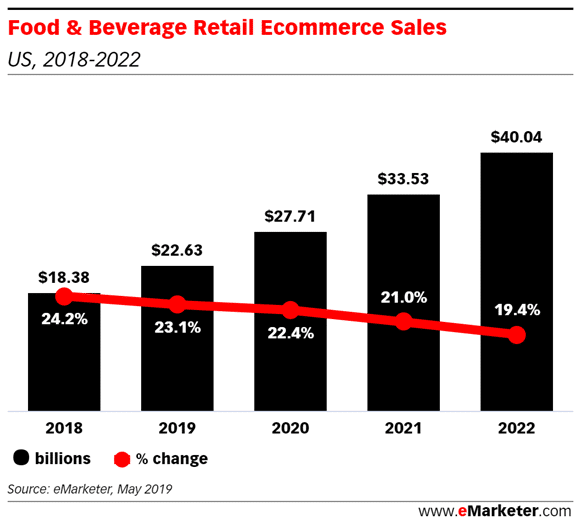Is grocery e-commerce here to stay?
With a pandemic and lock-downs entering the scene, the e-commerce space experienced huge growth. However, one category benefits from this more than any other: e-commerce for grocery shopping and food products. Is this trend here to stay? Or will it ebb down, as our lives return back to normal?
The rise of grocery e-commerce
Food & beverage retail e-commerce sales have been on the rise for a few years now. So far we have seen a growth of about 20% per year. If this trend had continued, sales should have reached about $40 billion per year in the US alone.

There are numerous reasons for this growth. Not only are millenials moving into their prime spending years and being being already used to online-shopping, we can also observe the percentages of elderly using the internet and starting to shop online rapidly rising.
Certainly there are also other enabling factors at play. With the experience we gained from traditional online shopping, infrastructures and processes have improved a lot and we are now at a point where shipping times and logistics are mature enough to support the delivery of perishable goods.
However, we can never fully predict the future and the course of this trajectory has changed, significantly.
In 2020, when the pandemic hit and lock-downs were put into place, more shoppers were filling their baskets online than ever before. About 40% of American shoppers were buying groceries in online stores during lock-downs.
This is quite significant for how the future of food e-commerce develops, as habits have already been formed. Many of those who bought groceries online for the first time in their life will stick with it. Many found benefits in it. Many fears, worries and doubts disappeared.
As a result, demand and development of solutions in the grocery e-commerce space are highly accelerated and predictions were adapted to +60% over what we expected pre-pandemic. Therefore, the predicted total grocery sales in the US will reach $250 billion in 2025.
That's a pretty large pie, but who will order the largest slice?
The big players are already moving in
It comes as little surprise that big companies are trying to get their foot into the door of this fresh market. Whichever player manages to establish himself as the dominant force in this space will reap great rewards.
Current major players trying to enter the market include Walmart, Amazon, The Kroger and Costco. Their moves didn't start yesterday, instead, they had their eyes on the space for quite some time now. In 2017 Amazon acquired whole foods market inc. for $ 13.7 billion and has since launched Amazon Fresh, the grocery delivery service available in US cities, Berlin, Hamburg, London, Milan, Munich, Rome, Tokyo, Singapore and India.
And it's not exclusively big US corporations either. Even here, in Austria, major supermarket chains like Billa and Spar began to promote and offer online grocery shopping, while new delivery services like https://www.gurkerl.at/ are on the move to disrupt the local online foods & beverages e-commerce market.
With all the big ones entering this space, will smaller businesses even stand a chance? Or should they just give up, as the battle is already lost before it was even fought?
Are smaller businesses doomed?
In contrast to what one might assume at first glance, my predictions for smaller businesses in the grocery, food & beverage e-commerce space are very bright for a multitude reasons.
One of the strengths of small businesses is and has always been the possibility to niche down for a specific target audience. This is true for almost any type of small business, whether we are talking about a small agency, a startup or a specialized store around the corner. The offerings of big companies will always feel generic and people will face trust issues when dealing with the big players. Who would you order groceries from? A local company, sourcing its products from local farmers or from a large corporation, offering the same item across multiple countries?
Customers are also becoming more conscious about their health and which items they consume. Have you noticed all the vegan stores and organic food stores popping up all over your town? It will be way easier for smaller businesses to take this market.
What about all the small breweries and craft-beer bars that appeared recently?
Small, local, specialized, niche food & beverage is a rising trend. One, which only smaller businesses can own.
Predictions
My prediction is that history will repeat itself.
In the past, we saw how commerce went online and huge companies emerged, yet personalized and specialized shops are still thriving. In the future we will see small, local, specialized stores for online groceries.
We saw how local stores started to act also as a warehouse for the shop's e-commerce operations and how local stores emerged that offered only pick-up and delivery, operating from a small storefront with most of the store being a warehouse. Dark Kitchens, restaurants without a walk-in, are already a thing when ordering prepared meals online. We will see a similar transformation in the groceries space.
And my final and most important prediction: The future for grocery e-commerce shopping is bright, both for large and small companies.